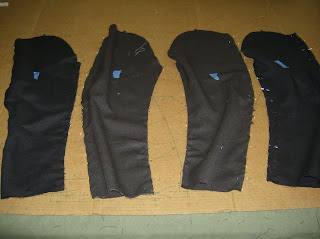I did the lace insertions by hand. For my first time attempting this type of insertion or any type of insertion for that matter. I am pretty pleased with the outcome. In the picture below, you can see that I have started to cut away the fabric behind the lace insertion on one side.
After the insertions were done, I moved on to adding the tucks. Again, this is something that I have never tried before. I was quite sure how they would turn out even with the instructions. There was still a bit to figure out. They are not perfect, but I can live with them.
A good view of the tucks and the insertions prior to me sewing the side seams.
I did a little more hand sewing to clean up the points at the bottom of the insertion.
Just a closer view of the camisole with the tucks and the insertions. I can't believe how lucky it was to have the lace be the exact width needed for the camisole. Again, I would not allow myself to purchase anything, I had to use what I had on hand.
Side seams have been sewn. I decided to finish all of the seams with a zigzag stitch. I still can get the hang of the french seam. I know that it is suppose to be very easy, but it hasn't come together for me yet.
Waist ribbon drawing string has been added, you can clearly see it near the bottom of the camisole.
Almost there, it is coming together nicely.
It is done for the most part, I still have to add the front closures, buttons and buttonholes. I plan to do those by hand and not use the sewing machine.
I am very pleased with the shape of the camisole. At this time, the fronts were still very full and the back was a bit higher. This you can see.
Closer view of the lace insertions, the tucks and the buttonholes. You can see my handy work with the bottonholes.
Once again, the buttons I had on hand and used them from my stash. They could have been a bit smaller, but I like them.
Buttons and more lace has been added to the front and back neck edge. The pattern called for lace to be attached to the arm area as well. I decided not to do that. So, this piece of the project is completely down.

























































